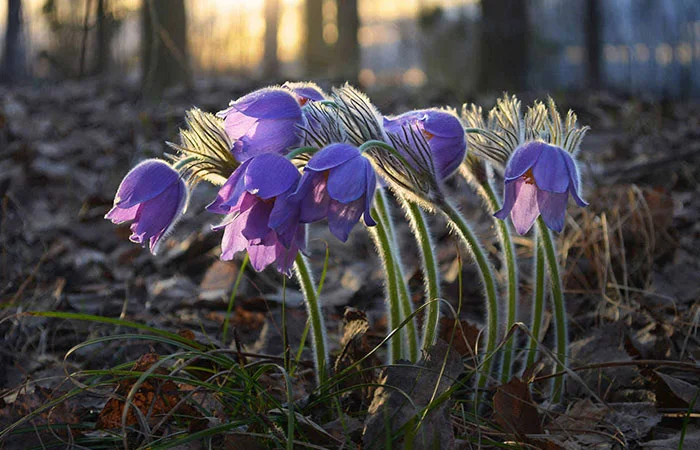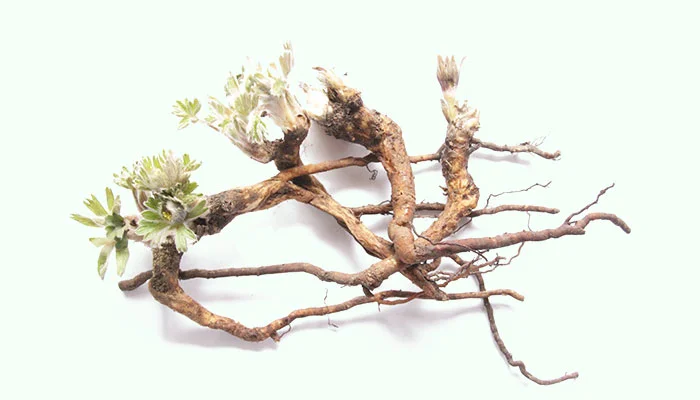What Is Bai Tou Weng
Bai Tou Weng also known as Radix Pulsatillae is the root of Pulsatilla chinensis, which is a perennial herb belonging to the family Ranunculaceae. It is a relatively practical and common Chinese herbal medicine with a medicinal history of over 2,000 years.
Pulsatilla chinensis is commonly known as Anemone chinensis and is an ornamental plant. It is distributed in northern China, North Korea, South Korea, Siberia and the Far East of Russia.
This plant is cold-resistant and drought-tolerant. It likes a cool and dry climate and often grows in hillside grasslands, forest edges, or sloping fields at an altitude of 200-3,200 meters.

In spring and autumn every year, people gather the roots of Pulsatilla chinensis, remove their impurities and fibrous roots, retain the white hairs on the root heads, wash them with water, moisten them thoroughly, cut them into thin slices, dry them in the sun, and make them into Chinese herbal medicines.
Bai Tou Weng contains anemonin, protoanemonin, flavonoids, pulchinenoside A, pulchinenoside B, pulchinenoside B4, triterpene acids, triterpenoid saponins, coumarin, lignans, betulinic acid, daucosterol, glucose, and rhamnose.
Generally, strong Bai Tou Weng with a pale yellow cross-section is preferred.
According to <Shennong Ben Cao Jing>, the medicinal nature of Bai Tou Weng is relatively cold, with a bitter taste. It has a certain therapeutic effect on the pathological changes of the stomach and large intestine meridians.
In traditional Chinese medicine, it is often used to clear heat and remove toxins, cool blood and stop diarrhea, treat bacterial dysentery, amoebic dysentery, amoebic liver abscess, scrofula, peptic ulcer, ulcerative colitis, chronic colitis, acute gastroenteritis, neurodermatitis, mumps, acute pyelonephritis, necrotizing enteritis, nose bleeding, uterine bleeding, hemorrhoid bleeding, and trichomonas vaginitis. It is the main component of Bai Tou Weng Tang.
Benefits
- Anti-inflammatory, analgesic, sedative, and anticonvulsant effects.
- Killing amebic protozoa, Trichomonas vaginalis, Coccidia, and Schistosoma japonicum.
- Inhibiting influenza virus, respiratory syncytial virus, herpes simplex type I virus, and enterovirus 71.
- Reducing oxidative stress and the release of reactive oxygen species, increasing the activities of antioxidant enzymes and glutathione, and inhibiting cell apoptosis.
- Inhibiting tumor cell growth, blocking tumor cell cycle, and inducing tumor cell apoptosis.
- Inhibiting angiogenesis, regulating cell energy metabolism, reversing drug resistance, and inducing autophagy of tumor cells.
- Inhibiting cisplatin-induced acute kidney injury and improving renal function.
- The pulchinenoside can increase the contents of TNF-α, IL-1β, serum immunoglobulin G, immunoglobulin M and complement 4, and enhance immunity.
- The pulchinenoside B4 can inhibit the activation of spleen lymphocytes induced by lipopolysaccharide and concanavalin, inhibit delayed hypersensitivity, and regulate immunity.
- Clearing damp-heat in the stomach and intestine, removing noxious heat in the blood system.
- Treating tenesmus, dysentery with bloody purulent stool, abdominal pain caused by pyretic dysentery.
- Treating chronic bloody dysentery and relieving cold abdominal pain.
- Relieving swelling and pain, treating sores, carbuncles, scrofula, and mumps.
- Cooling blood, relieving hematemesis, nose bleeding, uterine bleeding, hemorrhoids bleeding caused by blood heat.
- Alleviating fever and irritability caused by warm malaria.
- Inhibiting Staphylococcus aureus, Staphylococcus Albicans, Bacillus anthracis, Streptococcus A, Streptococcus B, Streptococcus suis, Pseudomonas aeruginosa, Bacillus typhi, Bacillus paratyphi, Escherichia coli, Pasteurella, dysentery bacillus, diphtheria bacillus, Bacillus subtilis, Mycobacterium tuberculosis, Candida albicans.
- Studies have confirmed that it contains protoanemonin, which has a certain therapeutic effect on lung squamous cell carcinoma, undifferentiated carcinoma, and melanoma.
- The topical application of its decoction can treat pudendal itching and abnormal leucorrhea.
Combinations
- It can be used in combination with Huang Lian (Rhizoma Coptidis), Huang Bai (Cortex Phellodendri), Qin Pi (Cortex Fraxini), etc. to treat tenesmus, dysentery with bloody purulent stool, abdominal pain caused by pyretic dysentery.
- It can be used in combination with E Jiao (Colla Corii Asini), Gan Jiang (Dried Ginger), Chi Shi Zhi (Halloysitum Rubrum), etc. to treat chronic bloody dysentery and cold abdominal pain.
- It can be used in combination with Pu Gong Ying (Dandelion), Lian Qiao (Fructus Forsythiae), etc. to treat scrofula and mumps.
- It can be used in combination with Di Yu (Radix Sanguisorbae), brown sugar, etc. to treat functional uterine bleeding.
- It can be used in combination with Xia Ku Cao (Spica Prunellae), Xuan Shen (Radix Scrophulariae), Da Huang (Radix et Rhizoma Rhei), etc. to treat Pseudomonas aeruginosa pneumonia.
Side Effects
- It contains protoanemonin, which can stimulate the skin and mucous membranes, inducing skin inflammation, blistering, tearing, sneezing, or coughing.
- A small proportion of patients taking it may cause salivation, gastrointestinal inflammation, vomiting, abdominal pain, nephritis, hematuria, heart failure, and even respiratory failure and death.
Precautions and Warnings
- The dosage of Bai Tou Weng should be controlled at 9-15g.
- When using fresh Bai Tou Weng, the dosage should be controlled at 15-30g.
- If the fresh Bai Tou Weng is heated or stored for a long time, its protoanemonin transforms into anemonin, which is not irritating.
- It can be made into injections and decoctions.
- People who are allergic to Bai Tou Weng should not take it.
- Patients with diarrhea due to deficiency-cold should not take it.
- Pregnant women and children should not take it.
